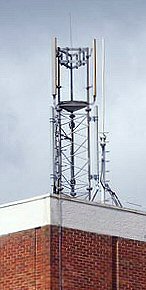| |
An investigation of the effects of the Airwave Tetra signal on cellular calcium and brain function
DSTL Biomedical Sciences, Porton Down
The pulse frequency involved in TETRA has given rise to concern that the behaviour of certain elements such as calcium and potassium, which are key to neural functions, may be released from cells. It is therefore vital to know if these elements do indeed resonate or respond, as reported by a number of earlier researchers.
 In their experiment, the DSTL researchers exposed brain granule cells for 20 minutes to measure effects on calcium within cells. This was followed by a further 10 minute exposure. In their experiment, the DSTL researchers exposed brain granule cells for 20 minutes to measure effects on calcium within cells. This was followed by a further 10 minute exposure.
 The experiment was repeated for effects on potassium with an initial exposure for 20 minutes, followed by a further 20 minute exposure. The experiment was repeated for effects on potassium with an initial exposure for 20 minutes, followed by a further 20 minute exposure.
 The third part of the experiement was on cardiac muscle cells, to determine effects on rhythm and the function of calcium. Again two exposures of 20 minutes were made. The third part of the experiement was on cardiac muscle cells, to determine effects on rhythm and the function of calcium. Again two exposures of 20 minutes were made.
Conclusion
There were no statistically significant effects from exposure to the Tetra signals.
What we would really like to know
- After 20 years and 20,000 research papers, one key researcher queries whether this is a well thought out and competent study. Devising experiments like this, he says, normally takes years to think through to get right in terms of validity, dealing with unexpected results, analysis and repeatability.
- Has this study, upon which the Home Office and Health Protection Agency (ex-NRPB) prefer to rely rather than on research with contra-indications, been peer-reviewed prior to publication? Why not?
- What is the DSTL ‘replication of the Tetra signal’? Described as ‘two signal generators and associated hardware’, this is very non-descript. What comparison can be made, for example, between the equipment used, practical use of TETRA handsets, and exposure to proximate base station antennae?
- The calcium experiment measured intracellular calcium exchange (and found no effect). The big concern is intercellular calcium efflux: ie leakage from cells, about which the experiment has nothing to say.
- How does the 20 minute exposures compare with officers using handsets 10 hours a day, 5 days a week? On what premise have all cumulative effects been ignored?
- How does exposure to cell cultures or brain slices compare with whole body/system exposure? If EM resonance due to body dimensions has any role to play, they will be absent here.
- The element describing epileptiform activity is wholly inadequate, with the presumption that any epileptic response has to be from induced frequencies (and in the absence of resonant dimensions) alone. See our paper on this subject that widens the issue significantly.
For something so important, how can this study therefore be relied upon as definitive?
 Read the DSTL reports on the Home Office site Read the DSTL reports on the Home Office site
 back back
|
 TETRA on BT building, Dursley
TETRA on BT building, Dursley
|






